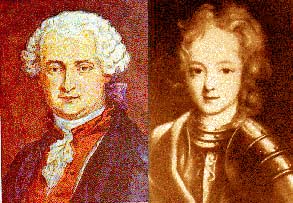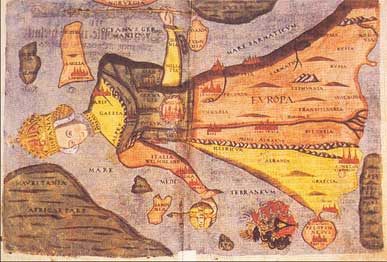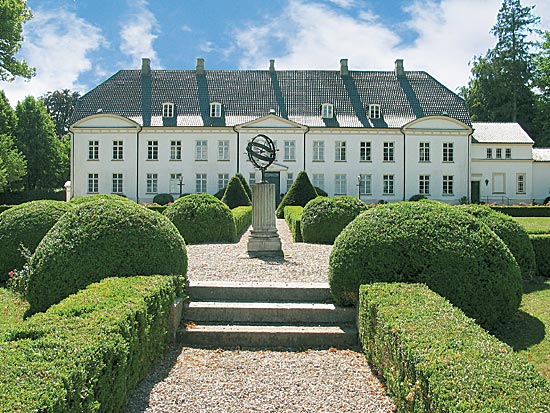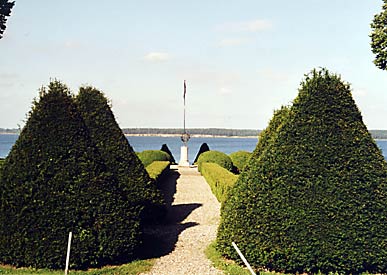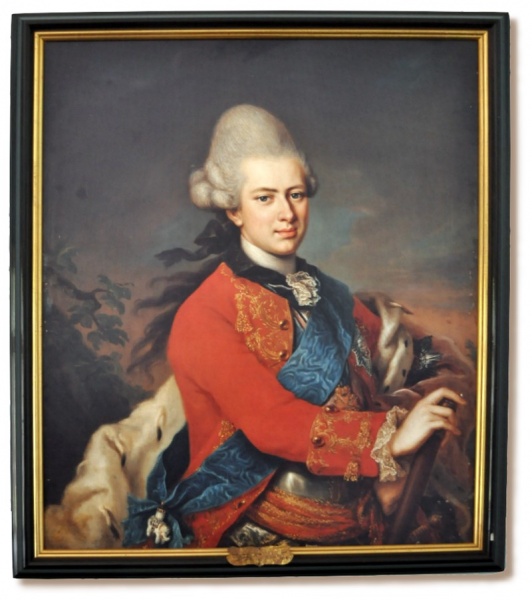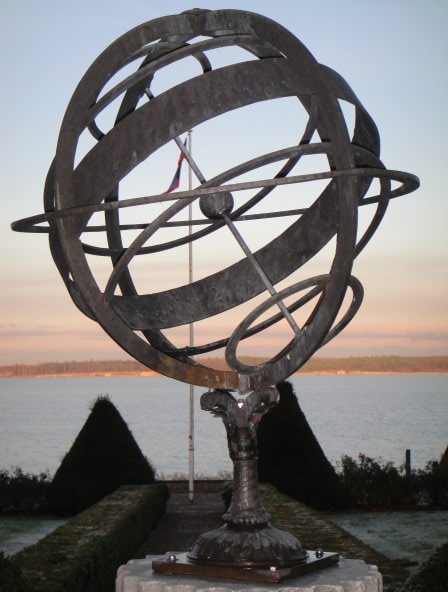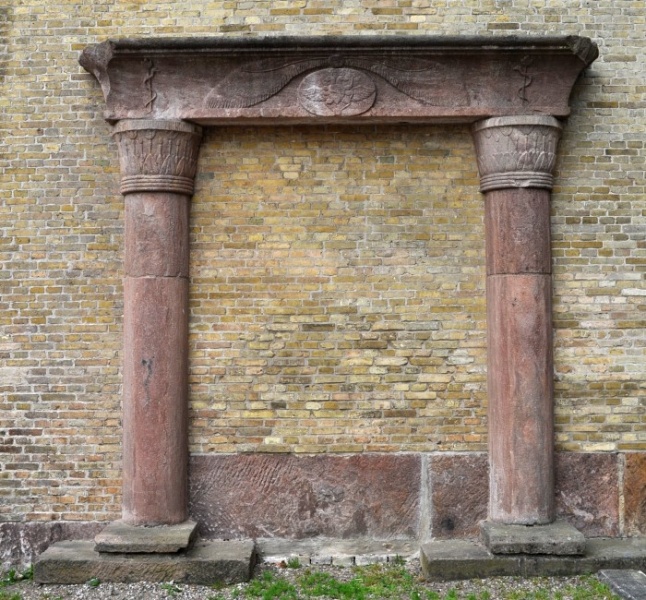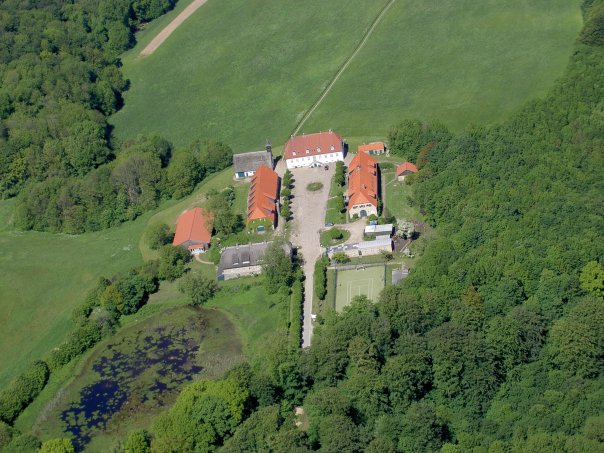Photo 2
PART 1 - Hermetic Garden & Tower, by Iona Miller, 2010
Walk in magician and philosopher St. Germain's footsteps in his last home, mystery school, temple and laboratory. He lived at Louisenlund in the later 1700s with his patron Landgrave Karl von Hessen-Kassel (1744-1836). They conducted experiments and initiations in the Hermetic Garden, among the megalithic stones and in St. Germain's Gothic alchemical tower - “All Brothers in Art”, Philosophers of Nature. All life is fire, the soul of things, the light that emanates from it is our mercury and this all rises from the salt of the earth.
ST. GERMAIN’S HERMETIC GARDEN:
By
Earth, is it not this that you want: to rise
invisibly in us? – Is that not your dream,
to be invisible, one day? – Earth! Invisible!
What is your urgent command if not transformation?
Earth, beloved, I will. O, believe me, you need
no more Spring-times to win me: only one,
ah, one, is already more than my blood can stand.
Namelessly, I have been truly yours, from the first.
You were always right, and your most sacred inspiration
is that familiar Death. --Rilke
"Count St. Germain was certainly the greatest Oriental Adept
The Wonderman
Count St. Germain is still considered one of the greatest philosophers who ever lived. He has become a cult figure, even demigod, for some, but a real person lies behind the legends. The archetypal Enlightenment mystic was called a man without a birth certificate or death certificate, which like many facets of his life is only partially true.
He was no saint but he was a rare spirit gifted with intuition, talent and intelligence. Prince Karl heard that when the Count's brother and sister received the titles and names Saint Karl and Saint Elizabeth from Emperor Charles VII, he himself had adopted the name Sanctus Germano, "the holy brother." But St. Germain probably bought the countdom of San Germano and its title from the Pope.
He was likely born between 1695 and 1710. There are competing theories of his pedigree, but he styled himself as a displaced Prince of Transylvania, which would make him a scion of the Dragon lineage, a bloodline bred for rulership and magic. Many researchers believe that St. Germain was the son of Francis II of Transylvania (1676-1735). If so, his father would have been only 19 when he was born. In the uprising of 1703-11 he lost the title Franciscus II Rakoczi. Dei Gratia Sacri Romani Imperii & Transylvaniae princeps.
Francis II’s second wife was Charlotte Amalie of the House of Hesse. He married her in 1694 when she was 15. Though debated, St. Germain was either her son, or the prior wife’s in this scenario. If so, Prince Karl would be his German cousin. His name was Leopold-George and they staged his death in 1700 to save him from the deadly collapse of the Transylvanian dynasty. The long war cost the nation the lives of 85,000 men and many more wounded, and at the end all the blood seemed to have been shed for a lost cause. Or was it?
Though the short-term result was certainly defeat, the liberation movement had thrust into leadership the noblest and purest figure in Hungarian history. Rakoczi was a leader who sacrificed his entire life, his domestic happiness and his estates for the cause of Hungarian liberty. He was able to revive a nation ruined by 150 years of Turkish rule and downtrodden by Habsburg suppression.
Against all odds, Rakoczi restored the people's pride and hammered out a cohesive, hard-hitting entity from a heterogeneous population composed of Magyars and Slovaks, Ruthenians and Wallachians, Transdanubians and Transylvanians, Catholics and Protestants, serfs and nobles, poor and rich - and was able to hold a huge empire at bay for eight years.
This unique feat has been an inspiration for the Hungarian nation ever since. In fact, losses on the Habsburg side were greater than those on the insurgents during the Kuruc-Labanc War which, historians tell us, led the Habsburgs to the verge of bankruptcy. This was the main reason the Court had pushed so hard for peace.
Francis II went into exile in France giving up his properties by refusing to swear allegiance to the Emperor. After Paris, he retired to a monastery to garden and spent the end of his exile in Turkey. He died in 1735 at age 60.
Was St. Germain the heir of this legacy of freedom fighters? This necessity for concealing is one of the great keys to the strange history of the man. Being a royal exile explains a lot about his behavior and acceptance at courts. The Emperor's "secret weapon" was none other than Amelia, who since 1701 had been prevented by the Court from joining her husband with her two sons, Jozsef and Gyorgy, although as a princess she was allowed to mingle with high society in Vienna.
Prince Karl of Hesse, Masonic leader of Germany, wrote that St. Germain was sent down to Italy to be raised by the Medici family. The children of Francis Racoczi were brought up by the Emperor of Austria, but one of them was withdrawn from his guardianship. The will of Francis II mentions a third unknown son. Whether the child was the first or third son, there was a price on the Crown Prince's head from age 7 because no heir could be tolerated.
St. Germain was a relentless activist, compassionate philanthropist, solicitous courtier, a backpocket agent, and a behind the scenes political reformer. But like modern celebrities, he kept his private life well-hidden behind a kaleidoscope of masks -- multiple personae.
But Prince Karl described him as "appearing to be consumed by an intolerable sadness," not hard to imagine by his disenfranchised childhood. Melancholia is associated with the very first operation of alchemy -- the Nigredo. If St. Germain was stuck in this unrefined state, he hadn't gotten very far in spiritual alchemy. Today we would say he was clinically depressed. Perhaps the burden of the lost kingdom weighed heavily on him. He also suffered from rheumatism. Some claim he had a stroke that paralyzed his tongue, but Prince Karl says he retained his faculties to the end.
Much of the time St. Germain was under deep cover even when hiding in plain sight. He was charismatic, a natural hypnotist and engaged in symphonic displays of mind control and sleight of hand. He let audiences believe what they thought they saw. He burned ideas into the muddy brains of those around him, leaving them always free to choose whether they would take the obvious course or not, and to escape the influence of mere curiosity if they could.
Nearly all the members of royal families in every country travelled under an alias. As a person of consequence, he did the same. As the missing heir, he may have had more reason than most. In his time, most aristocrats were somehow involved in secret societies His life had as many facets as the diamonds he brokered. In some sense history has granted him "immortality."
Yet, one contemporaneous account claims, "Saint-Germain showed, " they say," terrors in dying; is last moments were tormented by a distress of mind which was betrayed by exclamations in an unknown language. . . . He expired after a long agony in the midst of his enthusiasts, astonished to see him follow the ordinary law of nature!" But even that may be dime-novel elaboration.
The 'Bohemian' could be described as a man without a country, yet all were his until he wore out his welcome. Academic and freemasons have systematically tried to expunge him from their records. The only way such a paradoxical life can be described is by a paradox. He was an opportunist. When help was available he used it, he sought it out. When it eluded him, he created it anew. He was one who sought nature and " worked with her ". Nature made obeisance, recognizing him as one of her creators. There we have the secret of his limitations -- natural law.
Enigmatic Holy Brother
According to his close friend, Prince Karl of Hessen-Kassel, Count St. Germain was the youngest of the two sons of exiled Prince Francis II Rákóczi. With the defeat of Francis II, his properties were confiscated, and his youngest son was placed under the protection of the last Duc de Medici. His grandfather was from Florence and had contacts in Tuscany. First, the child's death certificate was faked.
When the children were forced to surrender the Rákóczi name and his brother and sister received the titles and names of St. Karl and St. Elizabeth, the boy said to himself, "Very well, then. I shall call myself Sanctus Germano, the Holy Brother." He was forced "undercover" from birth to save him from the clutches of the usurping Hapsburgs, who didn't want a third Hungarian uprising led by sons of the old regime. Perhaps denied his throne, he became a powerful transnationalist.
He continued the practice of using cover personae during his career as an international spy. Again, it was a matter of expediency to hide his origins and sympathies. He simply adopted a new identity for each locale. He showed up in a gaudily clad Paris always dressed in somber tones. This original Man In Black sported white lace cuffs and collar. Perhaps black best set off his dazzling collection of diamonds and precious stones. He had "Bling."
He distinguished himself in the company of writers, philosophers, scientists, freemasons and artistocrats. He was a talented pianist, singer, and violinist. Besides English, French and German, he spoke fluent Spanish, Greek, Dutch, Italian, Russian, Portuguese, Chinese, Sanskrit and Arabic -- for he had visited those countries and more.
In 1715, the young Count secretly left the boarding school in Siena (or Vienna, according to others), and embarked on long trips that took him to Central America first, where he studied the culture of the Maya and Aztecs. Some say he got married and absconded with that wife's jewelery. From there he went to Lisbon and on to Turkey, and to Persia from Malta.
From 1725 - 1726 he held court alternately in Malta, Naples and Rome. 1727 was his first trip to India, where by his own statements he learned the method of making artificial diamonds and deepened his knowledge of alchemical art significantly. In 1729 he returned to his foster father, who became Grand Duke of Tuscany in 1721.
He learned goldsmithing, alchemy, how to "dope" stones, and other arcane lessons at the court of the Shah of Persia. Today the color of stones is routinely enhanced using radiation. He was also a fine artist, art critic and historian. Perhaps he did travel "back in time" in his foreign journeys to lands that remain largely unchanged today. Immersed in their ancient customs, it may have seemed so. But it was probably closer to Einstein's thought experiment traveling a beam of light, or the astral travel of Theosophy, than time travel.
1743 he was reported in in London, accused as a spy for the Stewarts. He went to France around 1748, where Louis XV employed him as a spy several times. Around 1760 he was forced to leave France for England. There he taught Count Cagliostro the Egyptian Rite of Freemasonry. During his two-year stay in London in 1743 he set up a laboratory and did mysterious experiments. He likely learned or honed his encryption skills there, too. Both of his favorite books, Trinosophia and Triangular Book were in cypher text. His cypher manuscripts were encrypted using a simple substitution crypto key. Code in both alchemy and politics offered a measure of secrecy and protection from the Inquisition. In the east, he may have been introduced to crypto, first recorded by the Arab polymath Al-Kindi in the 800's. St. Germain was also known to use polyalphabetic cyphers and masonic alphabets.
Many early cryptographic works were esoteric, mystical, and/or reputation-promoting, cryptography being mysterious. Roger Bacon wrote the first English work on cryptographics, followed by Dr. John Dee, who was both magician and spy. The classic 'banned' Steganographia by Trithemius (written c.1499; Frankfurt, 1606, placed on th Index Librum Prohibitum in 1609, removed in 1900) appears to be about magic - specifically, about using spirits to communicate over long distances. Spooks and spirits have a long association.
Since the publication of the decryption key to the first two of three volumes in 1606, they have been known to be actually concerned with cryptography and steganography. Until recently, the third volume was widely still believed to be about magic, but the "magical" formulae have now been shown to be covertexts for yet more cryptography content. The work has lent its name to the modern field of steganography. Layers of such deeply encrypted messages may remain in St. Germain's books, waiting to be decyphered.
St. Germain mingled with British nobility at the Kit-Kat Club, astounding members by talking of two of his inventions in progress -- the steam train and steamboat (20 years before James Watt). He met Bulwer Lytton and inspired the novel Zanoni, whose protagonist is a Rosicrucian adept and herbalist with the secret of preserving long life.
In 1744, he visited Frederick the Great and the Rosicrucians of Vienna. While St. Germain was living in Vienna he spent much of his time in the Rosicrucian laboratory on the Landstrasse, and at one time lived in the room which Leibniz occupied in 1713. St. Germain also worked with the Fratres Lucis, and with the "Knights and Brothers of Asia" who studied Rosicrucian and Hermetic science and made the "philosopher's stone" one of the objects of their research. In 1747 Empress Maria Theresia sent him a secret mission to lead peace talks with the Duke of Cumberland on the battlefield in Flanders. The Empress give thanks the Count for her portrait with a valuable ring, gave him the Imperial Cross and invested him with the "real" title of Imperial Count of Milan. In October 1748 peace was concluded at Aachen.
1745 St. Germain left London for Vienna where he was known as a mystic and philosopher. He became intimate friend of Emperor Francis I's chief Minister, Prince Ferdinand von Lobkowitz. Through this friendship he met the Marshal of France, the Duc de Belle-Isle, special emissary of Louis XV of France at the Viennese Court.
In 1755 he returned via Madegascar to India on The Stretham with Captain Clive.
1757 Duc de Belle-Isle took Saint-Germain to Paris and, being the Minister of War and associated with the high class, the Duc of Belle-Isle most likely introduced the Count to the Court Circles of France and to both Louis XV and Madame Pompadour.
1759-1760 The Count stayed in Chambord dedicated to the production of artificial diamonds for King Louis XV. Always the back-pocket agent, in The Hague, he acts as a secret peace negotiator of the king.
In 1762, during the Palace Revolution, Saint-Germain St. Petersburg. Due to the Empress Catherine II, he is appointed General and the title and name of Count Soltikow awarded. So, those who claim he was not really a Count are mistaken. He appears in Pushkin’s novel The Queen of Spades as the lover who gave a Russian duchess the secret of winning at cards.
1769 - In Venice, he set up a factory for bleaching flax to resemble silk. after which he went through Dresden, Leipsic, and Hamburg to Eckernfijrde in Schleswig
1770, returned to Paris and prophesied the French Revolution to Marie Antoinette and her friend, Madame d'Adhémar, who wrote a story of his abilities as an Adept.
1773 he traveled to Mantua after meeting his pupil Cagliostro in Paris.
1774 Schwabach as Count Tzarogy developing his recipes for fine leathers, after going to Tunis in 1770. From 1774 to 1776 he met several Rosicrucian and alchemists at Triesdorf. In the later part of 1776 he attended a high council meeting of Rosicrucians at Leipzig, and next year he helped to establish a Rosicrucian College and Alchemical laboratory at Dresden.
1779 - 1780 the Count is in Gottorp as guest at the court of the Landgrave and governor of Schleswig-Holstein, Karl von Hessen-Kassel. From 1780 - 1782 he experimented with him in the Phoenix workshop in the basement of the alchemist's tower in the park at Karl's summer residence Louisenlund. Together, they managed to create a goldähnliches metal, later known as Carl metal, and planned for its production on a larger scale to create jobs.They met iIn 1779 when he was in Hamburg to consult with a group of Rosicrucians. Then he visited the home of Prince Karl of Hesse, who was then the Grand Master of the Rosicrucians in Germany. Around that time he paid a visit to the Castle of the Duc of the Medici which had an archive for the preservation of the Rosicrucian material from all parts of Europe.
At the Masonic Congress held in 1782 Wilhelmsbad, the Count introduced his self-written set of rules that should unite all the Templars, Rosicrucians and Freemasons.
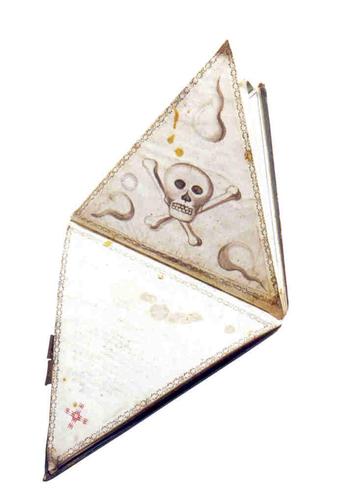
Cult of Personality
He was an occult personality and his modern adherents form cults around his legend. During his life, people projected great good and evil onto him and this has not abated over time. He is their spiritual drug. His detractors characterized him as a charismatic narcissist at best and a con man at worst, but never mean or foul. But it is near impossible to tell if any of the stories are actually about him.
He is the object of much occult speculation. He was also a devoted student of yogic and tantric disciplines, which he learned during his long retreats into the heart of Asia. A student of the Eastern system of concentration, he was seen on several occasions sitting with his legs crossed and his hands folded.
Rather than a mystic, the allegedly immortal courtier was more of a "mystagogue," a person who initiates others into mystic beliefs, an educator or person who has knowledge of the Sacred Mysteries. This is not the esoteric magic of the Renaissance theurgist but the rhetorical universe of the spirited cosmologist rooted in poetic, theatrical words and tropes.
Language and magick were once considered the same thing. That's where we got the word "spell"; it's not just a name for a magickal operation, it is direct from the word for orthography and from the belief that anyone who could capture sounds in marks on paper must be a great magician. The word enchant derives directly from the belief that a wizard could capture someone else's will by chanting the proper phrases.
Thus, St. Germain claimed “I hold the whole of nature in my hands, and as God created the world, I can draw what I want out of nothing.” This sounds like modern claims of extraction of Zero Point Energy from the vacuum.
With nefarious eloquence the line blurs between occultism and new science. Mysticism, magic and experimentation are the crux of seventeenth and eighteenth century intellectual life. Metaphysical sensibilities do not shy away from grand ideas and idealistic tendencies broadening their worldview.
They were unraveling the enchanted cosmos of rhetorical mystery and charm. Words dressed ideas but were also enchanting devices to facilitate a metaphysical frame of mind infused with cosmic purpose and superluminary correspondences. The snake-charmer St. Germain excelled at such rhetoric.
St. Germain' probably died on February 27, 1784 from pneumonia contracted in his dank Gothic tower, but some insist his spirit has lived on in a variety of forms, still pursuing the art of creation and transformation. There are rumors he faked his death.
Earlier in life, his skill as an alchemist was praised by Louis XV, who provided him a laboratory and residence at the royal castle of Chambord. Hearing of Saint Germain’s experiences all over the world, his study of the Eastern mystical wisdom and his practice of the secret alchemical arts, Louis became fascinated. A group of students formed around him. These included Baron von Gleichen, Marquise d'Urfré and the Princess of Anhalt-Zerbst, mother of Catherine II of Russia.
He had alchemical labs in Vienna, Prague, London and Paris in which he faithfully sought the Philosophers Stone. In his retirement, he recreated the patronage of the late French King with Prince Karl of Hesse. He died in Eckernförde, near Schleswig in Denmark. Prince Karl of Hesse is said to have been not only acquainted with the fact of St. Germain's death at Eckrenförde but that his illness began while pursuing experiments with dye colors, his own apothecary preparing innumerable medicaments for his cure in vain.
There was no body, but Prince Karl, attested to his death, and his death certificate can be found in Eckernförde's Nikolai Church Register which claims he was entombed March 2. Shortly after, his unclaimed estate was sealed. There is no remaining grave because it was destroyed by the great storm tide on November 13, 1872. For whatever reason Prince Karl destroyed all his work notes. His experiments in alchemy in a subterranean laboratory may plausibly have compromised the octagenarian's lungs. He spoke of death in a "Philosophical Sonnet":
"Curious scrutinator of all nature,
I have seen gold thick in the depths of the double mercury.
I have seized its substance and surprised its changing.
I explain by that art the soul with the womb of a mother,
Make its home, take it away, and as a kernel
Placed against a grain of wheat, under the humid pollen;
The one plant and the other vine-stock, are the bread and wine.
NOTHING was, God willing, NOTHING became something,
I doubted it, I sought that on which the universe rests,
NOTHING preserves the equilibrium and serves to sustain.
Then, with the weight of praise and of blame.
I weighed the eternal, it called my soul,
I died, I adored, I knew NOTHING more."
--trans. Manly Palmer Hall in Sages & Seers, MS. in
Alas, longevity spells, elixirs and healthy diet are no protection against poison, particularly mercury. The Count attributed his occult knowledge to his journeys to the
However, Saint Germain neither confirmed nor denied this connection and said that what he knew he learned from his own application and research. His own science included a thorough knowledge of herbs and plants based on experiments with nature; from this base he invented several medicines and natural formulas for healing. We may not know much about the actual man, but we know more about the magical currents that fired St. Germain's personality.
Centuries earlier, Cosimo de Medici ignited the Renaissance by reviving pagan thought and practical pre-Christian wisdom. He appointed his physician's son, Marsilio Ficino as director of the “Platonic Academy” to oversight the translations into Latin of ancient manuscripts. These texts inspired philosophical and religious debates.
They described ancient Greek and Egyptian civilization with their lunar and solar mystery cults such as Eleusis, Isis and Osiris. The Masonic legend of Hiram Abiff is an adaptation of the Osiris myth. The link between those origins - via Orphic texts, Magical Papyri, Byzantine and Arab conjure books -- and the grimoires is non-controversial in academic magic.
The peak experience in the Mysteries, was meeting one’s Higher Self and the deities. This was a goal shared by the alchemists and Platonic Academy. A monk sold Cosimo a copy of the Corpus Hermeticum that lit a divine spark, and gave "rebirth" to European culture. Europe had a spiritual awakening that reverberated throughout the arts. Hermetics became a tradition with a set of philosophical beliefs rooted in gnostic Hellenism that fused early Greek and Egyptian religions, with the Egyptian Thoth / Greek Hermes as central cult figure.
The Great Secret: To Dare, To Will, To Know, To Keep Silent
We cannot really "enter" the Philosopher's Garden fully unless we understand the worldview of St. Germain. To immerse ourselves in it, we have to get inside his esoteric mindset. The mechanical view had not yet usurped the occult view.
We are surrounded on all sides by mythological reality -- the realm of the imaginal, of psychic reality. The power's in the secret and the secret's in the power, tapping the negentropic potential. The power of the Great Secret is that it is experiential, manifesting as embodiment, numinous and non-numinous experiences. The real question is why are there so few realized beings who have fulfilled their potential like St. Germain?
Much like Blake, the alchemists imagined the sublime arises from a sensual scrutiny so intense that it penetrates to an unbounded energy at the heart of distinct forms. Alchemists sought the naked existence of the mystery of being, Anima Mundi. Breaking through abstractions we experience concrete evens as discrete, unique patterns of transpersonal, ungraspable energy.
The vision of eternity arises outside time as the unconditioned awareness of the immediate present in the absence of the content of mind. Anima Mundi is an all-pervading essence, the innermost and secret numinosum in ourselves and the universe, that part of God which formed the quintessence and real substance of Physis, at once the highest supercelestial waters of wisdom and the spirit of life pervading inorganic matter. Experientially, it is nothing less than the rediscovery of light in the world soul, James HIllman (1982) describes a contemporary Anima Mundi:
"Let us imagine the anima mundi neither above the world encircling it as a divine and remote emanation of spirit, a world of powers, archetypes, and principles transcendent to things, nor within the material world as its unifying panpsychic life-principle. Rather let us imagine the anima mundi as that particular soul-spark, the seminal image, which offers itself through each thing in its visible form. Then anima mundi indicates the animated possibilities presented by each event, as it is, its sensuous presentation as face bespeaking its interior image--in short, its availability to imagination, its presence as a psychic reality. Not only animals and plants ensouled as in the Romantic vision, but soul is given with each thing; God-given things of nature and man-made things of the street."
The fusion of psyche and substance was evident in the projection of mythological content into the behavior of matter. Thus, the alchemist was one with his process of transformation. All phenomena are real and unreal in some sense. Today we know that the universe is not made of concrete "substance" but "wavicles" of energy/light. Energy and mass are convertable.
St. Germain was a "Renaissance Man" of his times. His intellectual beliefs, faith or "esoteric spirituality" do not fit current models of skeptical, atheistic humanism or biocognitive "epiphenomenal" theories of mind or consciousness. Esoterics was not a concept but a way of life. The occult revival resulted from religious reformation and secret societies became the retorts of revolutionary thought that led toward modern science and humanistic sociopolitical transformation.
The Knights Templar, steeped in Oriental knowledge during the Crusades, preceeded Freemasonry and Rosicrucians as the prototype of gnostic democracy. They realized powerful political acts can be acts of spiritual warfare. The esoteric Hermetic movement and the first system of lodges which emerged in Scotland around 1600 linked because the masons have a tradition that Hermes played a major part in preserving the knowledge of the mason's craft. He allegedly taught it to mankind after the great flood. The key development in craft history, the teaching of masonry by Euclid, took place in Egypt.
Rosicrucianism influenced the early development of Freemasonry. They were both philosophies of the transcendent nature of life. Alchemy played a major part in Rosicrucian activities. Alchemical symbolism figured in their initiation ceremonies and members were supposed to have their own laboratories, and work diligently at their furnaces, and retorts and crucibles.
The Order was grouped into circles of nine members each, and had nine grades of initiation, each involving elaborate initiation rituals. In ascending order, the grades were as follows: Junior, Theoreticus, Practicus, Philosophus, Minor, Major, Adeptus Exemptus, Magister and Magus.
To the already mixed masonic lore (the myth of Egypt, Solomon's Temple, The Hermetic quest), Rosicrucians added the myth of the secret order of invisible brethren, dedicated to the search for ultimate truths and to the understanding of our mysterious universe. In the process the personality becomes more refined. The artifex himself must be developed to his highest state, identification with Artifex Universus Mundi (Great Architect of the World).
The Rosicrucian movement and its venerable Master St. Germain played an important role in bringing Hermetic and esoteric Renaissance traditions into Freemasonry. Rosicrucians held unique spiritual values under opposition from traditional religion. The "awakening" is to unseen potential of concrete presences -- a new vision of reality.
They wanted to revolutionize society. The new ideology dared to imagine that in the true democracy each individual enjoys the widest range of possibilities and can fulfill more potential. Recognizing people's potential and involving them in nontraditional teaching-learning communities fosters personal and social transformation. They had a sense of mission and supernal philosophic destiny. This is what Prince Karl and St. Germain planned for Louisenlund as the sacred heart of Europe.
Initiation
The Count assumed a personal spiritual awakening, or an exalted moral development makes the Initiator qualified to transmit this spiritual influence by means of Symbolic Initiation. It was the 18th century version of spiritual empowerment -- the science-art of natural philosophy. There are political and conflictual tensions in esoterics. The only way out of this impasse of warring abstractions is to embrace a third term beyond the conflict. It is simultaneously the most traditional and the most radical: the original energy of the ancient universe, the disruptive power of the unpredictable present.
Esotericism confronts an entirely new additional dimension -- gnosis, which in many ways relies on "grace" -- the transcendent response to spiritual opening. This dimension cannot be addressed by conventional history alone, precisely because gnosis represents insight into that which transcends history. An imaginal or visionary revelation, for instance, occurs in time, but according to the visionary that which is revealed does not belong to time alone. Wisdom unfolds as does transformation, but it can also come in a lightning flash of emergent insight.
Another key structural aspect of esotericism is the concept of "initiatic grace" or the transfer of power or special ability from a teacher to a student. This inner structural process of esoteric transmission of understanding occurs not only through the simply learning of intellectual ideas or the mastery of a certain vocabulary or external ritual behavior. The experiential journey takes reflection and pro-active engagement.
The transmission is itself a medium of spiritual affirmation, an "awakening" by which the recipient comes to fully value the reality of that which is transmitted, subtly, silently, profoundly. This empowerment is seen as a psychic or soulful realization of fluid currents and emanations that constitute a more illumined state of awareness or a more empowered state of being. Often these currents are related to cosmic entities, sometimes mythicized and sometimes not, whose value is expressed in symbols of unification and wholeness.
Esotericism is defined primarily in terms of gnosis because gnosis, of whatever kind, is precisely what is esoteric within esotericism. ‘Esotericism’ describes the historical phenomena to be studied; ‘gnosis’ describes that which is esoteric, hidden, protected, and transmitted within these historical phenomena. Without hidden knowledge to be transmitted in one fashion or another, there is no esotericism.
Esoterics
The Persian alchemist Jabir (c. 800) wrote Kitab Sirr al-Khaliqa wa San`at al-Tabi`a (Book of the Secret of Creation and the Art of Nature). But he attributes this text to Apollonius of Tyana. It is the basis for the single most popular text in Western Hermeticism, translated into Latin (1140) as the Tabula Smaragdina.
This Emerald Tablet is the manifesto or prime directive of Hermetics. From the Renaissance period of the retranslation of the Corpus Hermeticum (found in Byzantium, the "east") into Latin by Marsilio Ficino (1471) there is a slow but continual referencing of "oriental" cultures and literatures as sources for esoteric thought and practice.
Alchemy, astrology, various kinds of magical traditions, Hermeticism, Kabbalah, Jewish or Christian visionary or apophatic gnosis—under the rubric of ‘Western esotericism’ are a whole range of phenomena connected primarily by one thing. To enter into the particular arcane discipline is to come to realize for oneself secret knowledge about the cosmos and its transcendence. In alchemical thought the phenomenon of transformation in the retort is coextensive with the adept who works through the operations and observes their result.
This secret or hidden knowledge is not a product of reason and experience alone, but of gnosis—according to esotericism, it derives from a supra-rational source. Most alchemists were not illumined adepts but devotees of nature who obscurely sensed the living wisdom of the Earth and sought to learn about it if not from it.
That photonic Light operates biochemically is a given in modern science, but the ability to participate consciously in photobiochemical or biophotonic processes is denied by science. The Horus current is one of biological Light. The Gnostic "light in extension" was the ultimate symbol of spirit. The crystalline form of DNA actually forms a dodecahedron.
The Count, a master of the mystic arts, undoubtedly learned disciplines such as theurgy, practical alchemy, astrology, astronomy, qabalah, geomancy, the arts such as music and painting, forms of divination, and rites of various magical lodges or orders. Metallurgy, distillation, dying paints and silks, and gemology were practical applications. All of these depend upon the doctrine of correspondences.
The term “mysticism” is fuzzy. It can mean visionary experiences, non-visionary via negativa experiences, or something else. The term “gnosis,” refers to direct spiritual insight either into hidden aspects of the cosmos, or into transcendence.
Gnosis includes: 1. knowledge or direct perception of hidden or esoteric aspects of the cosmos (cosmological gnosis) 2. direct spiritual insight into complete transcendence (metaphysical gnosis). Cosmological gnosis still entails a subtle dualism of subject-object, to some extent belongs to the realm of knowledge, and reveals correspondences between subject and object, or between humanity and the natural world.
Esoteric schools of thought can be compared externally by 1. Mythical origins; 2. Cosmic cycles; 3. Chains of initation; 4. Secret books; 5. Mystical names; 6. Occult etymologies; 7. Mystical Interpretation or translation; 8. Spiritual translation; 9. Magical uses (of esoteric writings or art works).
There are six characteristics of esoteric practice: 1. Correspondences & Interdependence 2. Living Nature 3. Imagination 4. Transmutation 5. Praxis of Concordance 6. Transmission.
Eight characteristics of esotericism include: 1. authorial impersonality; 2. an opposition of esoteric to exoteric; 3. the concept of the “subtle” mediating between spirit and matter; 4. a theory of correspondences; 5. the esoteric significance of numbers; 6. the ‘occult sciences’; 7. the ‘occult arts’; 8. initiation.
These correspondences may be drawn upon to achieve some aim, as in alchemy, astrology, or magic. Metaphysical gnosis is non-dualistic spiritual insight. This distinction is comparable to that found in the Corpus Hermeticum between “lower” and “higher” gnosis, “lower” referring to philosophic learning, “higher” to direct insight into the Nous.
Secret Books
A key eighteenth century Masonic figure in both the American and French Revolutions, St. Germain left little more than the legacy of fraternity in secret societies, and his two arcane books. Their authorship is arguable, but he valued them and his promotion of them is indisputable.
The Most Holy Trinosophia is an allegorical text and initiatory manual and the unpublished Triangular Book with the dragon emblem is a magical grimoire in the style of Solomonic magic. There is no proof St. Germain wrote it, but like The Lost Book of Nostradamus, his name is on it. And they were worthy of copying and safeguarding for hundreds of years. Manly Palmer Hall never published the Triangular Book though he had two copies. What ties all three together is the theme of the Precession of the Equinox in 2012. The winged dragon represents the Anima Mundi, or Soul of the World, which is the sum total of planetary existence -- the holographic blueprint on which form is based, informational level or primal source of being. It is said that medicine providing the gift of youth can be made from its venom. The dragon is a healing power. The spiritual food of immortality signifies the ability of the ego to assimilate the previously unconscious aspects of the Self. This is the elixir of youth that creates the immortal body, equivalent to the Philosopher's Stone.
Both of these hoary tomes are heavily encrypted with triple meanings, containing layers of Hermetic, Qabalistic, and alchemical secrets. We can imagine they encapsulated the pinnacle of his wisdom for his associates.
In Trinosophia, we read: "My dear Philochatus, you are about to penetrate into the sanctuary of the sublime sciences; my hand is about to raise for you the impenetrable veil which hides from the eyes of common men the tabernacle, the sanctuary wherein the Eternal has lodged the secrets of nature. . .kept for a few that are privileged, the few Elect whom His omnipotence created that they may SEE, and seeing, may soar after Him in the vast expanse of His Glory and deflect upon mankind one of the Rays that shine round about His golden Throne."
The Triangular Book is a theurgic rite with three stated goals, which can be taken at face-value or metaphorically. They include finding treasures lost to the sea since the Great Flood (long-hidden, antediluvian sources of esoteric wisdom), spells for finding and mining diamonds and other gems beneath the earth (VITRIOL), and invocations to maintain the appearance of a 50 year old.
Many believed Count St. Germain a.k.a Count Surmont, Count Welldone, Count Soltikoff, Count Tzarogy, Marquise di Aymar, Prince Rakoczi, or Ahasverus, found the "Elixir of Youth." It doesn't stretch the imagination that besides his laxative Senna Tea, he was probably aware of ginseng and fo-ti tieng from his Asia travels. He could easily make a compound of all the rejuvinating herbs he knew from his travels. It may have remained secret, since Europeans would have been largely unfamiliar with those plants, anyway.
A soul that enjoys the flow of spirit is self-sustaining, self-referencing and self-aware. Such a soul has the possibility of immortality. Perhaps there is a way to live beyond one's years by radiating one's influence -- by being a catalyst for change in others. The alchemical power of Azoth took three forms: the Philosopher's Stone, the power of projection and the elixir of life. St. Germain believed in Universal Medicine and practiced hypnosis. Perhaps he exploited the placebo effect, improvement in health or behavior not attributable to a medication. He passed his secrets of gnosis and hypnosis on to Anton Mesmer.
Rosicrucians were known as "long livers." In the preface to a book entitled Long-Livers (1772), Eugenius Philalethes, the Rosicrucian initiate, thus addresses his Brethren of the Most Ancient and Most Honorable Fraternity of the Free Masons: "Remember that you are the Salt of the Earth, the Light of the World, and the Fire of the Universe. You are living Stones, built up a Spiritual House, who believe and rely on the chief Lapis Angularis which the refractory and disobedient Builders disallowed. You are called from Darkness to Light; you are a chosen Generation, a royal Priesthood. This makes you, my dear Brethren, fit Companions for the greatest Kings."
Prima Materia
The alchemical process takes place in the Hermetically sealed vessel of the psychophysical self. Here vessel and stone are one: the irreducible quality of the Self. All superficial and unnecessary aspects of the personality are washed away. It is equivalent to the incorruptible diamond body. It relates to a crucial change of attitude which comes about over time through the repeated solution and coagulation of the opus. Gradually ego and self become more closely aligned and that manifests as an immunity to affect and an ability to see through the archetypal aspect of existence. This ‘diamond’ stone is identical to the vessel in that it is created by the very containment of the process.
Occultist, Paul Foster Case described Alchemy in his Introduction to Tarot Lesson 10: "The alchemical process is a physical process directed and controlled by mental means. It aims at a transformation of the human body. When this transformation is effected, the adept has a physical vehicle by means of which he is able to exercise unusual powers, among them being the ability to transmute metals. His own body is his laboratory and its organs or athanors are the "secret vessels" employed in the work of an alchemist. When this transformation is effected, the adept has a physical vehicle by means of which he Is able to exercise unusual Powers, among them being the ability to transmute metals."
The alchemical formula VITRIOL suggests we Visit the interior of the Earth and mine our unconscious to find the Philosopher’s Stone, an analogy for mining the treasures within ourselves. Later, Carl Jung saw a proto-psychology of self-transformation and evoked potential in the work of the alchemists and made it the basis of his depth psychology.
Jung saw in alchemy's rich, magical, medicated symbolism the outlines of individuation, the lifelong enrichment of consciousness and its actualities by contact with the unconscious and its potentialities. Jung found in alchemy the bridge between Gnosticism and psychology and the historical counterpart to his concept of the collective unconscious.
Alchemical language helps us stay close to image: its words are thing-words, image-words, craft-words. It talks of personality in terms of concrete material: salt, sulphur, mercury, and lead. It describes states of soul in terms of events that we can touch and see: albedo, rubedo, nigredo. When we use these words, and the whole array of sweating kings, dogs and bitches, heavy earths, ascending birds, stenches, urine, and blood, we remain in touch with image and this keeps us in the realm of psyche.
Jung discovered that the artifex, the alchemical researcher who preceded both chemist and psychologist, projected into matter's dark mystery the search for the Self or spark of God, archetypal center and organizer of personality. It is symbolized by the trapped spirit Mercurius or Hermes, derived from the Egyptian Thoth. Hermetic operations are not performed by the artifex (the alchemist-artisan) acting alone, but by the concerted actions and linked psychic projections of artifex, the environment and the transpersonal domain.
This "diamond self" mined from one's depths is the Lapis Philosophorum, the Philosopher's Stone that extends life, heals all sicknesses, and transform base metals into gold. This "gold" is no ordinary gold; this wisdom no ordinary wisdom. In the last conjunction the Stone transfigures itself into a clear, incorruptible, eternally living crystal -- the quinta essentia, the fifth element and universal medicine.
Feeding on this negentropic energy symbolizes the truth and wisdom, knowledge and spirit extracted from matter. The garbled secret is that this imaginal body is also Sophia's supernatural body -- the body of wisdom -- the organic Light. The secret of the Art is to phase over by imaginal technique (the artifex) from being unconsciously inserted in nature to conscious engagement with nature -- to coevolution. This was one of the primary aims of the Mysteries whose adepts were dedicated to the Wisdom Goddess embodied in the Earth: Sophia.
St. Germain's metaphysical manuals are more relevant today than ever. Manly Palmer Hall, owner and publisher of both these rarest occult books, deduced that they related to the Great Year of the Precession of the Equinoxes. He claimed, the keynote throughout this material describes the approach of an age when the Leg of the Grand Man and the Waterman of the Zodiac (likely Orion & Aquarius) meet in conjunction at the equinox and end a grand 400,000 year cycle.
This culmination of eons is mentioned in the Apocalypse as a revealing: "Behold! I make a new heaven and a new earth," meaning a series of new cycles and a new humanity." This last comment is a reference to the precession of the equinoxes and the Sun's entrance into Aquarius in 2010 which ushers in a new zeitgeist, a dramatic shift in cultural paradigms.
Retirement Rituals
Though his effect was that of a cultural engineer, St. Germain was a diplomat, spy, inventor, occultist, jeweler and violinist. As such, he was fluent in many languages, including those of encryption. His life is full of rumors, legends and scandal, making it hard to separate the man from the myth. But he fostered Masonry, gnosis and the Rosicrucians creating a legacy that persists today.
Though many of his exploits are couched in mystery, much is known about St. Germain’s retirement period at Louisenlund on the German/Danish border, where he practiced Freemasonry and alchemy with his patron Prince Karl of
At Louisenlund on
Magnum Opus
Together, the the Hermetic brothers sought practical magical knowledge -- the secret of the Philosopher’s Stone, of transforming iron to gold, and the elixir of immortality. The nature of alchemy is that it simultaneously transforms the spirit and soul of the practitioners through a series of operations.
Working, often alone, in their mystically decorated laboratories, staring lovingly into their bubbling contraptions, alchemists sought a fabulous living amalgam called the Philosopher's Stone which symbolized their own brand of salvation. Legend claimed this Stone could transmute ordinary metals like lead and brass into gold; that it obliterated sickness and restored health; that it bestowed on the artifex ("artificer": the alchemical adept) long life and physical regeneration; that it provided a self-replenishing well of secret knowledge. Alchemists dedicated their lives and sometimes lost them in their mystico-scientific endeavor to unearth Mercurius, the alchemical Spirit in the Stone, and thereby tap the divine power in matter.
With an alchemical laboratory and initiatory temple at its heart, the Danish Governor, Prince Karl built an occult playground using a symbolic visual language. He named the estate after his wife. His motto was “Omnia cum Deo,” “All in communion with God.” He was married to Princess Louise (1750-1836), the sister of the Danish king, Konig Christian VII who gave her the property as a wedding gift in 1770. Karl became Provincial Grand Master for the Masonic activities of the whole north, including
Landgrave Karl was one of the key Masons before and after the French Revolution. His mystery school practiced prayers and asceticism to awaken spiritual faculties and invoke celestial beings with special rites and underground and celestial initiations.
His influential lodge brothers spoke respectfully of him and he gathered them as aristocratic emissaries of an emerging world of brotherhood. From age 35, Karl spent four summers with St. Germain, who worked to give to the poor, commuting to the estate from the Eckernforde paint factory and silk dying operations the octagenarian oversaw for Prince Karl.
St. Germain promised him they would focus on astounding subjects such as Tantra and experiments – the deep secrets of nature and human development. Some accused or mis-accused Karl of being fanatical and gullible. St. Germain did confide his practical knowledge of herbs, plants, drugs, metals, stones and coloring paints and dyes. As for the rest, we can only conjecture. In 1816, he drafted his “Memoirs” of St. Germain, calling him, “the greatest mind I knew.” Prince Karl was a more fervent Christian than the heterodox St. Germain, who argued religion. They imagined a society that developed human potential.
Prince Karl was not only a Grand Master of the Rosicrucians and Order of the Asiatic Brethren, but many other orders and rites. Though a patron of the Reformed Church and a political conservative, he was known as Master +Mimin-Ta+ and St. Germain called Master +Elixir-Ra+ was his mentor. He was convinced with proper spiritual training he could communicate with the spirit world. There were certainly attempts to do so – invocations -- described in St. Germain’s Triangular Book.
They realized the Bavarian Illuminati could derail Freemasonry and lead to social chaos through materialism. Now acting as Spymaster, St. Germain dispatched Prince Karl to infiltrate the Illuminati and acquire the names of that lodges’ members. German Freemasons were infiltrated by Adam Weishaupt of the Illuminati, whom the Count knew personally, knowing his intent and evil core. From this fertile hiding ground, they did their mischief.
The confusion today about whether the Freemasons are Divinely inspired or something more sinister, dates from this time period. Together, they temporarily blocked their expansion. They wanted to neutralize the Illuminati and destroy their power once and for all. Or, so the story goes. After the French Revolution, the Illuminati rite was prohibited in
